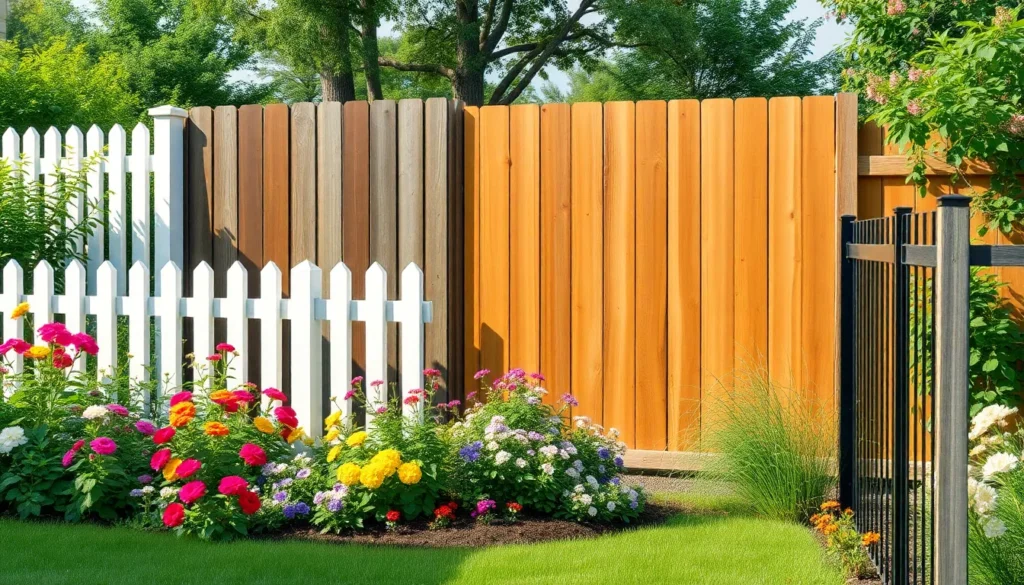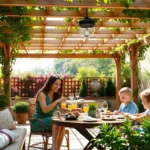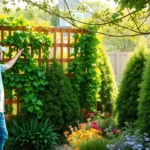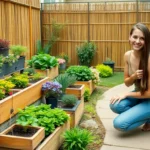When we’re designing our dream garden space, choosing the right fence can make all the difference between a mediocre outdoor area and a stunning sanctuary. A well-chosen garden fence doesn’t just define boundaries – it creates privacy, adds visual appeal, and protects our precious plants from unwanted visitors.
We understand that selecting the perfect fencing solution can feel overwhelming with countless materials, styles, and heights to consider. Whether you’re looking to create a cozy cottage garden feel with a classic picket fence or seeking modern minimalist panels for a contemporary industry, the right fence becomes an extension of your home’s personality.
From budget-friendly DIY options to premium designer answers, we’ve explored the most effective fence ideas that’ll transform your garden into the outdoor oasis you’ve always envisioned. Let’s jump into the possibilities that’ll enhance both your property’s value and your daily enjoyment of your outdoor space.
Classic Wood Fence Ideas for Garden Boundaries
Wood fences remain the most popular choice for garden boundaries, offering timeless appeal and natural beauty that complements any industry design. We’ll explore three classic wooden fence styles that provide excellent privacy, security, and aesthetic value for your outdoor space.
Traditional Picket Fence Designs
White picket fences create the quintessential American garden boundary with their charming cottage appeal. These fences typically stand 3-4 feet tall and feature evenly spaced vertical slats with pointed or rounded tops. Paint refreshes every 3-5 years to maintain their crisp white appearance and protect against weather damage.
Decorative picket styles offer endless customization options through varied heights, spacing patterns, and ornamental tops. Consider scalloped edges, alternating heights, or Gothic points to create visual interest. Many homeowners choose natural wood stain instead of paint to showcase the grain patterns while requiring less maintenance.
Gate integration transforms picket fences from simple boundaries into welcoming garden entrances. Install matching gates with decorative hardware, arbor tops, or climbing plant supports. Position gates strategically to create natural pathways and focal points throughout your garden space.
Cedar Privacy Fence Options
Solid cedar panels provide maximum privacy while naturally resisting insects, rot, and weather damage without chemical treatments. These fences typically range from 6-8 feet tall and feature tightly fitted boards with minimal gaps. Cedar’s natural oils maintain its integrity for 15-20 years with proper installation and occasional cleaning.
Board-on-board cedar fences create complete privacy while allowing air circulation through alternating panel placement. This design prevents warping and extends fence life by reducing wind pressure. The overlapping boards create attractive shadow lines that add visual depth to your garden perimeter.
Cedar lattice combinations blend privacy with decorative appeal by incorporating lattice panels above solid boards. This two-tier approach provides security at ground level while creating opportunities for climbing plants like clematis, jasmine, or morning glories. The lattice sections typically add 1-2 feet of height while maintaining an open, airy feeling.
Rustic Split Rail Fence Styles
Three-rail split fences offer the most authentic rustic appearance using naturally weathered cedar or locust posts and rails. These fences stand approximately 4 feet tall and work perfectly for defining garden areas without blocking views. Installation requires no nails or hardware since rails fit into mortised post holes.
Zigzag rail fences create distinctive boundaries using interlocking rails that form a zigzag pattern across your property. This colonial-era design requires no posts and uses gravity to maintain stability. Each section typically spans 10-12 feet and can be easily relocated as garden needs change.
Split rail with wire mesh combines rustic charm with practical functionality by adding welded wire mesh to prevent small animals from entering garden areas. The mesh attaches to the rail interior and remains nearly invisible while protecting vegetables, flowers, and young plants. This combination works especially well for kitchen gardens and flower beds.
Modern Metal Fence Ideas for Contemporary Gardens
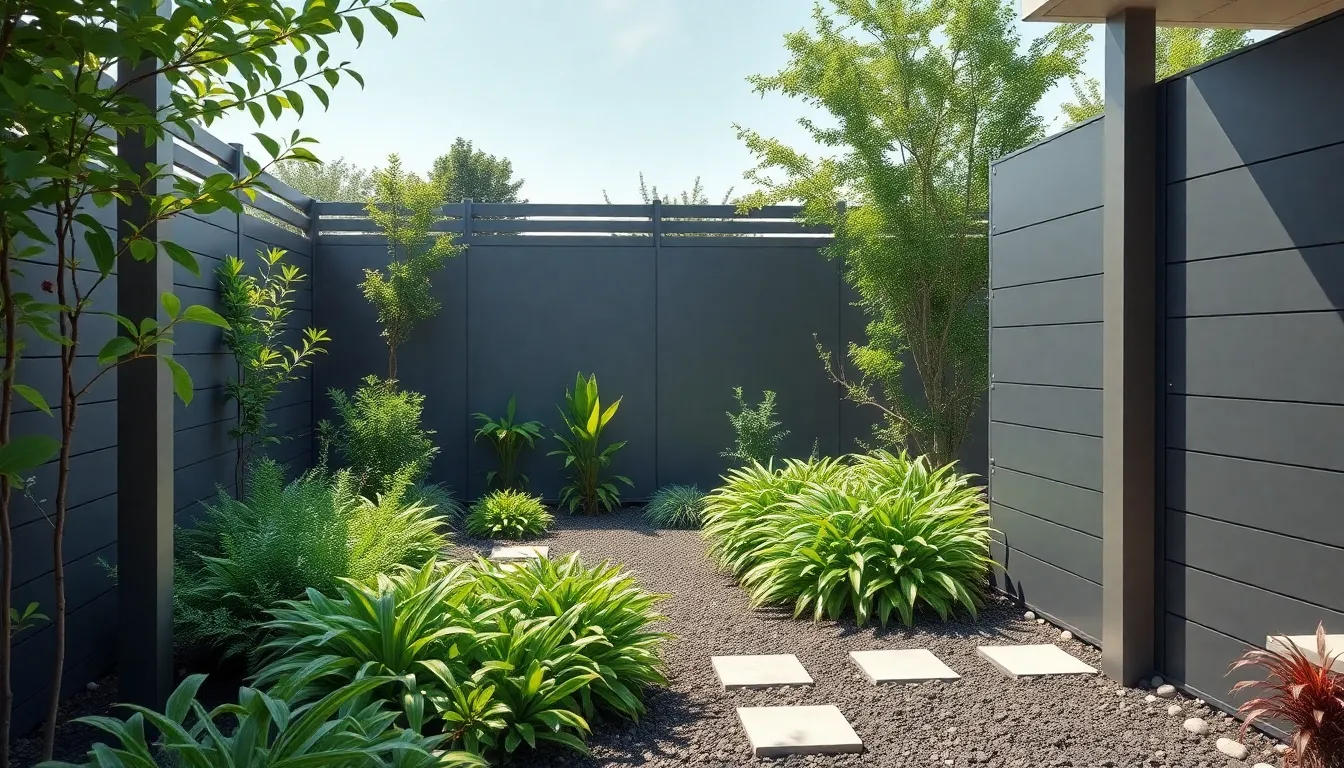
Metal fencing brings sophisticated elegance to contemporary garden spaces while delivering exceptional durability. We’ll explore three standout metal fence options that perfectly complement modern industry designs.
Sleek Aluminum Fence Panels
Aluminum fence panels deliver minimalist aesthetics through their simple, flat horizontal top rails and vertical pickets. These contemporary designs create clean lines that enhance modern garden settings without overwhelming the natural beauty of your plants.
Lightweight construction makes aluminum panels easy to install while their corrosion resistant properties ensure long lasting performance. We appreciate how these panels require minimal maintenance, allowing you to focus on enjoying your garden rather than fence upkeep.
The streamlined appearance of aluminum fencing works exceptionally well with contemporary hardscaping materials like concrete and stone. You can choose from various heights to create privacy or simply define garden boundaries while maintaining an open feel.
Industrial Steel Fence Designs
Industrial steel fences feature horizontal bars or slats that create an open, sleek appearance while maintaining security and functionality. These designs offer perfect answers for gardens embracing modern or industrial themes.
Steel’s inherent strength allows for wider panel spans and thinner profile elements, creating sophisticated visual impact. We often see these fences paired beautifully with contemporary art installations or striking architectural plantings like ornamental grasses.
The horizontal orientation of steel slat designs draws the eye along the fence line, making garden spaces appear larger. Weather resistant coatings protect steel fences from the elements while maintaining their crisp, professional appearance for years.
Decorative Wrought Iron Fence Options
Wrought iron fences showcase intricate scrollwork, fleur de lis motifs, and laser cut patterns that add elegant traditional charm to garden spaces. These decorative features create stunning focal points while providing excellent security.
Weathered and patina finishes give wrought iron fences rustic flair that pairs beautifully with stone or wood garden elements. We love how these varied finish options allow you to customize the fence’s appearance to match your garden’s overall aesthetic.
Laser cut geometric patterns in wrought iron offer artistic flair that suits contemporary gardens seeking unique visual elements. The combination of traditional craftsmanship with modern cutting techniques creates truly distinctive fencing answers that serve as garden art installations.
Natural Living Fence Ideas for Eco-Friendly Gardens
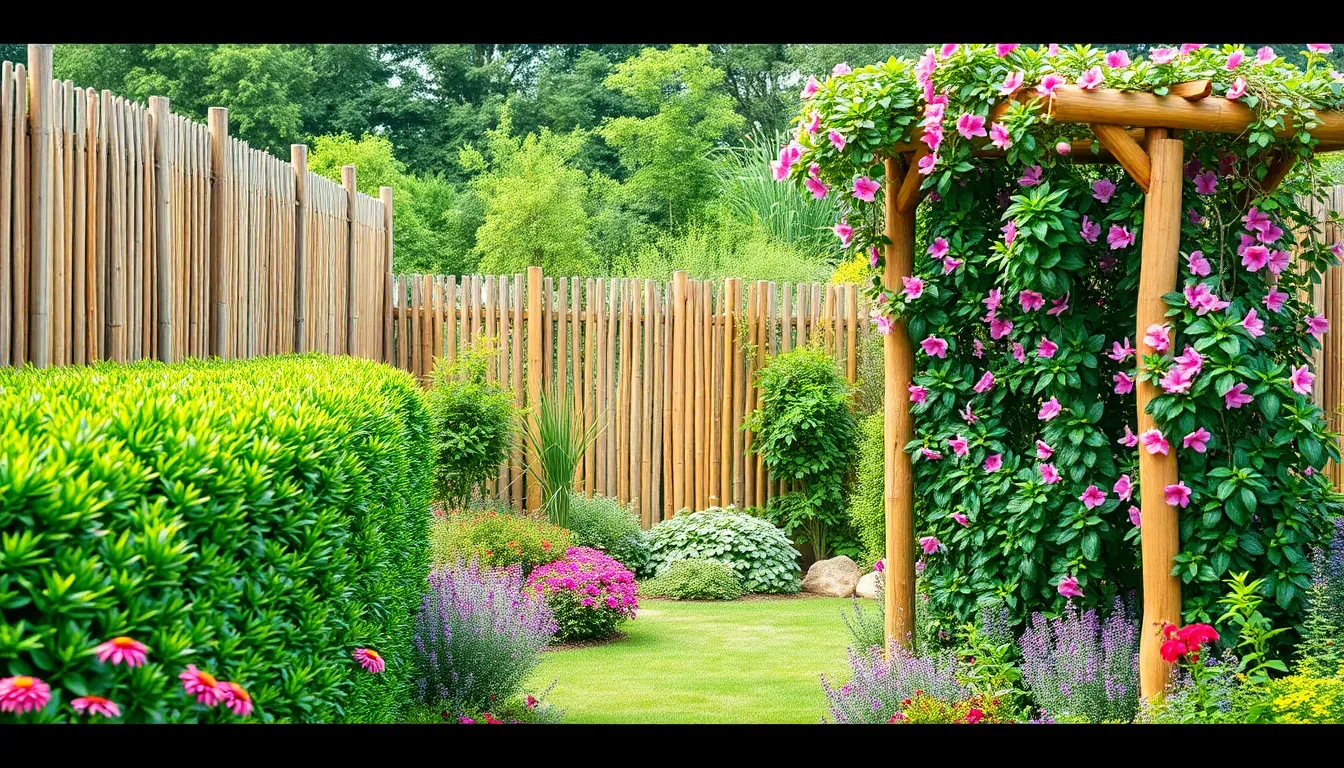
We’re shifting our focus from metal and wood to explore sustainable fencing answers that work harmoniously with nature. These eco-friendly options not only provide privacy and boundaries but also contribute to a healthier garden network.
Hedge Fence Plant Varieties
Boxwood stands out as our top choice for formal hedge fences because of its compact growth pattern and exceptional ability to maintain precise shapes through regular pruning. This evergreen shrub creates dense, uniform barriers that provide year-round privacy while requiring minimal water once established.
Privet offers rapid growth rates that make it perfect for gardeners who need quick results. We can shape this hardy plant into various heights and widths, and its fast-growing nature means you’ll have a substantial hedge within just two growing seasons.
Holly brings natural security to your garden boundaries with its thorny leaves that deter unwanted visitors while creating beautiful dense hedges. The glossy green foliage provides excellent coverage, and many varieties produce colorful berries that attract beneficial wildlife to your garden space.
Bamboo Fence Installation Tips
Quality bamboo selection forms the foundation of any successful bamboo fence project. We recommend choosing properly treated bamboo poles that resist rot and pest damage, as untreated bamboo can deteriorate quickly in outdoor conditions.
Durable post installation ensures your bamboo fence remains stable for years to come. Metal or pressure-treated wooden posts work best as anchor points, and we suggest spacing them no more than 6 feet apart for optimal support.
Secure attachment methods keep your bamboo slats firmly in place through various weather conditions. Wire ties or galvanized screws work effectively to connect bamboo pieces to support posts, and we recommend checking these connections annually for any needed adjustments.
Vine-Covered Trellis Fence Systems
Wooden trellis structures provide excellent support for climbing plants while adding vertical interest to garden spaces. We prefer cedar or redwood materials because they naturally resist decay and complement most garden styles with their warm, organic appearance.
Metal framework options offer superior durability and can support heavier vine growth over many seasons. Powder-coated steel or aluminum trellises resist rust and maintain their structural integrity even when supporting mature climbing plants like wisteria or grape vines.
Climbing plant selection determines both the visual impact and maintenance requirements of your living fence system. Ivy creates dense coverage quickly, clematis provides seasonal flower displays, and wisteria offers dramatic blooms but requires regular pruning to prevent overwhelming growth patterns.
Creative DIY Fence Ideas for Budget-Conscious Gardeners
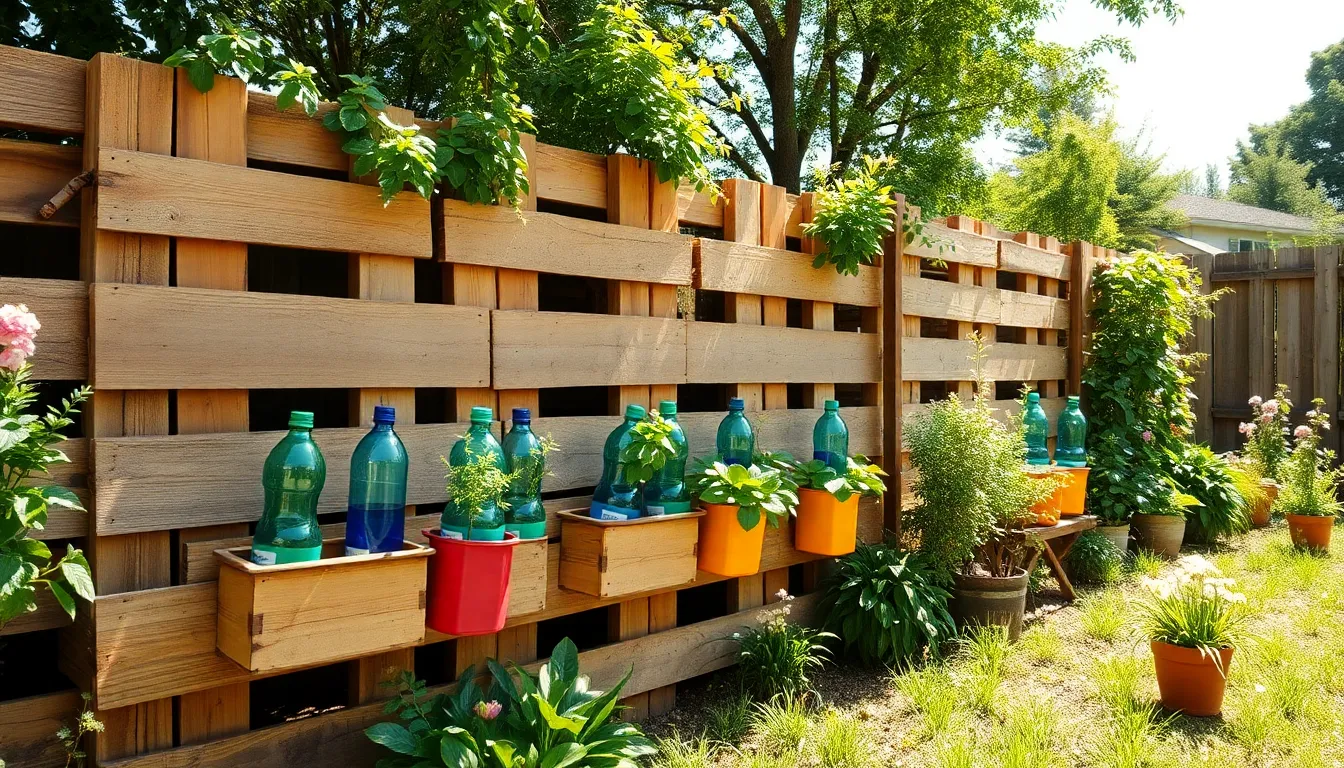
Budget constraints don’t have to limit your garden fence dreams. We’ve discovered ingenious ways to create stunning boundaries without very costly.
Repurposed Pallet Fence Projects
Pallets transform into one of the most cost-effective fencing answers available to gardeners today. We can disassemble these wooden structures and arrange them in various patterns to create unique garden boundaries. The materials you’ll need include pallets, screws, and a drill for assembly.
Start by securing the pallet pieces with screws to ensure structural integrity. Add a protective coat of paint or stain to extend the fence’s lifespan and enhance its appearance. This approach typically costs under $30 for small garden areas and provides excellent customization options.
Consider alternating pallet orientations to create visual interest along your garden perimeter. The rustic texture adds character while maintaining functionality for plant protection.
Recycled Material Fence Designs
Recycled materials offer endless creative possibilities for eco-friendly garden fencing answers. Old doors and windows make exceptional focal points when attached to wooden posts, creating rustic charm throughout your garden space.
Plastic bottles serve as innovative planters that attach directly to wooden fence structures. This dual-purpose design provides colorful visual appeal while promoting environmental sustainability. We recommend securing bottles with weatherproof brackets to ensure long-term stability.
Other recycled options include old bed frames, bicycle wheels, and discarded wooden furniture pieces. Each material brings unique character while reducing waste and construction costs significantly.
Simple Wire and Post Fence Answers
Wire and post fencing delivers maximum effectiveness with minimal investment for small garden areas. The essential materials include wooden posts, wire mesh, wire cutters, and basic fastening hardware.
Place posts strategically around your garden perimeter, spacing them 6-8 feet apart for optimal support. Attach wire mesh between posts using wire cutters and heavy-duty staples, then secure connections with screws for added durability.
This straightforward approach typically costs less than $25 for gardens up to 100 square feet. The open design allows air circulation while protecting plants from larger pests and defining clear garden boundaries.
Decorative Fence Ideas for Garden Aesthetics
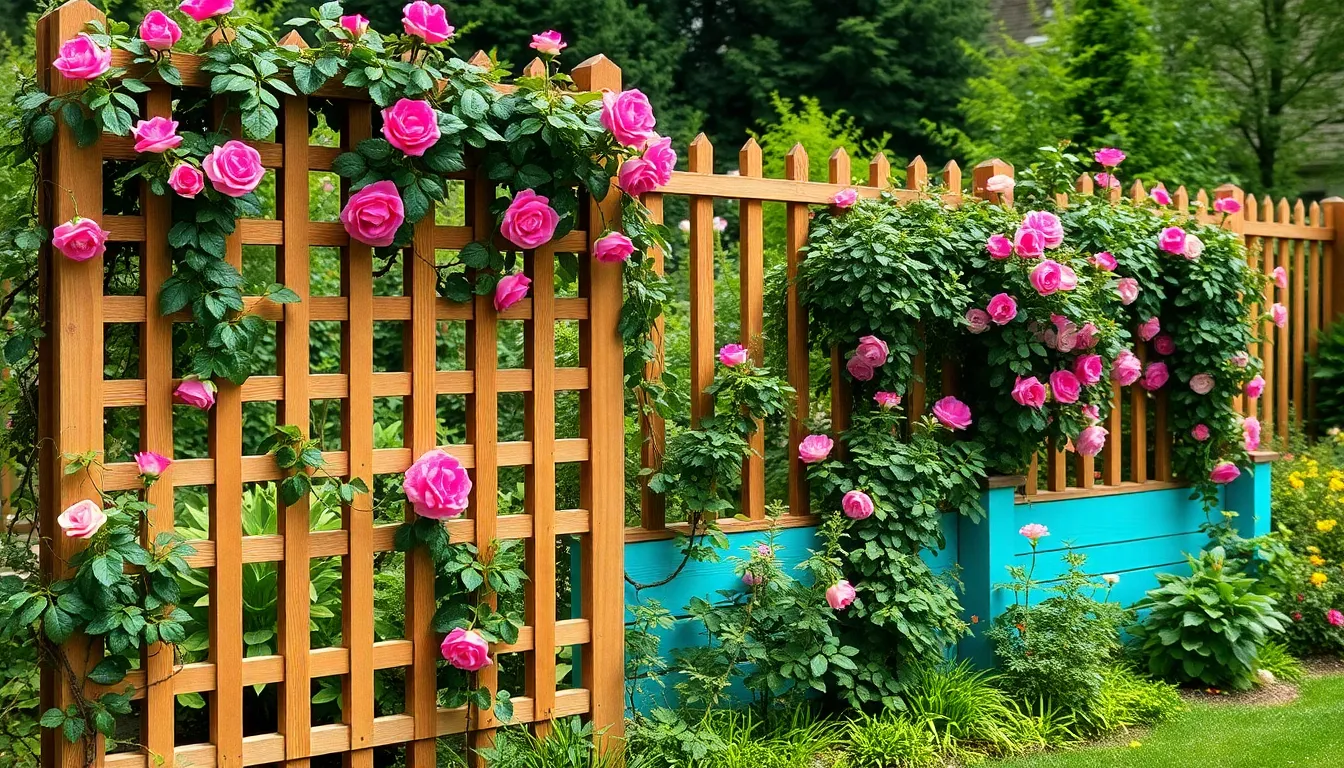
Decorative fences transform ordinary garden boundaries into stunning focal points that enhance both visual appeal and functionality. Let’s explore sophisticated options that’ll elevate your garden’s aesthetic while serving practical purposes.
Lattice Fence Pattern Options
Square lattice patterns create classic grid formations that work beautifully as standalone fencing or privacy screens atop solid walls. We love how these traditional designs provide structure while allowing light and air to filter through naturally.
Diamond lattice configurations offer a more ever-changing visual appeal with their diagonal crisscross patterns. These versatile panels serve as excellent trellises for climbing plants like roses and clematis, creating living green walls that blend functionality with decorative charm.
Custom geometric designs let you personalize your garden boundaries with unique patterns customized to your space. Modern homeowners often choose hexagonal or contemporary angular patterns that complement architectural elements while maintaining the practical benefits of traditional lattice work.
Ornamental Fence Top Designs
Scalloped fence tops add gentle curves that soften harsh lines and create flowing visual transitions between garden sections. These elegant designs work particularly well with wood fencing where the curved patterns can be cut precisely for consistent spacing.
Arched fence tops bring architectural interest through their graceful upward curves that draw the eye skyward. Metal fences commonly feature these designs combined with ornamental scrollwork for enhanced visual impact.
Speared fence tops provide both security and style with their pointed vertical elements that deter climbing while adding dramatic height. We often see these designs on wrought iron fences where spear points create striking silhouettes against the sky.
Finial fence tops crown each post with decorative elements ranging from simple balls to elaborate carved designs. These finishing touches help define outdoor spaces and significantly enhance curb appeal through their attention to detail.
Colorful Painted Fence Styles
Bright color statements transform ordinary fences into garden showpieces using bold hues like turquoise, yellow, or vibrant pastels. Pressure treated or cedar wood fences provide durable surfaces that hold paint finishes for years with proper preparation.
Muted tone blending creates subtle garden boundaries that harmonize with natural surroundings through earth tones and soft grays. These understated colors let your plants take center stage while maintaining defined garden spaces.
Stenciled pattern designs add artistic flair through repeated motifs like flowers, geometric shapes, or nature inspired elements. We recommend using weather resistant stencils and quality exterior paint for long lasting results.
Chevron pattern effects bring modern geometric interest through zigzag designs that create visual movement along fence lines. These contemporary patterns work especially well in urban gardens where bold design elements complement architectural surroundings.
Ombre color transitions create stunning gradient effects that shift gradually from light to dark or between complementary colors. This technique works beautifully on wood slat fences where each board can represent a step in the color progression.
Privacy Fence Ideas for Secluded Garden Spaces
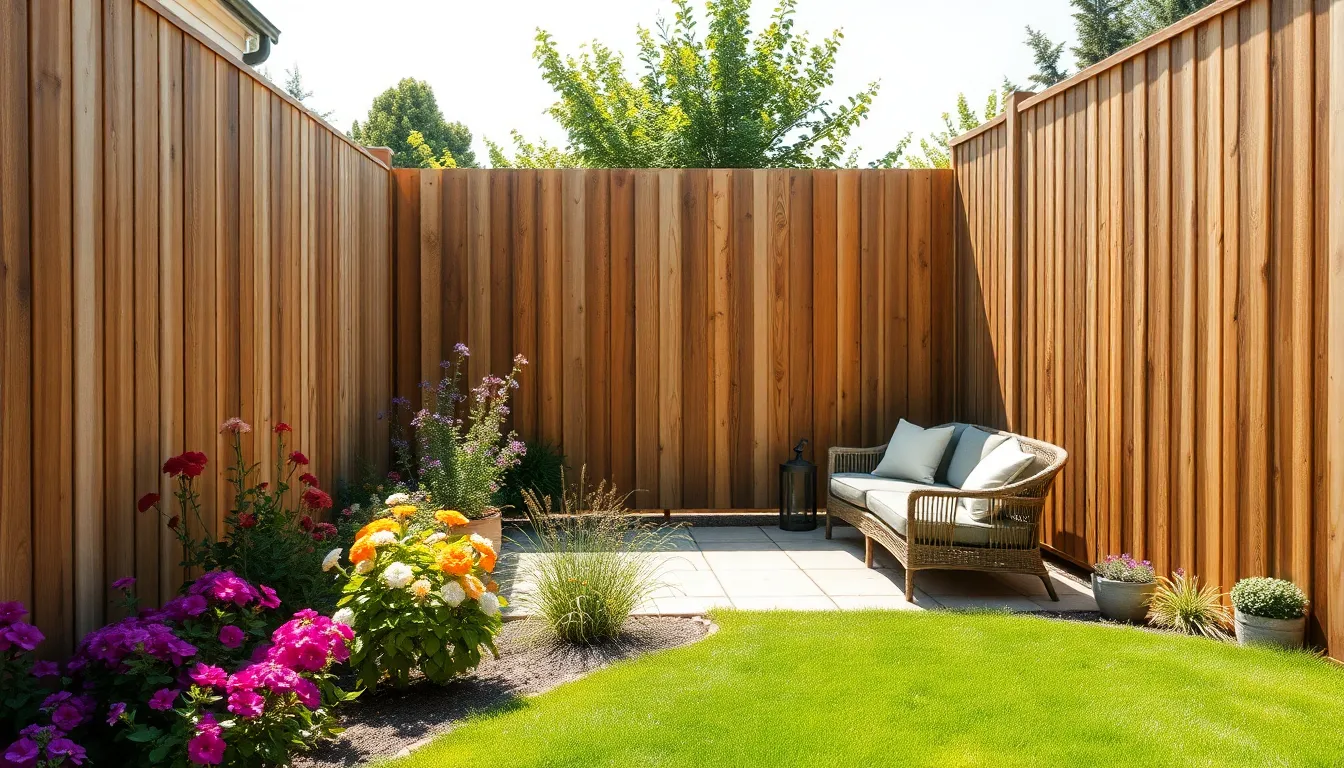
Privacy transforms outdoor spaces into personal sanctuaries where we can relax without unwanted attention. Creating a truly secluded garden requires thoughtful fence selection that balances functionality with aesthetic appeal.
Tall Solid Panel Fence Designs
Stained wood fences deliver exceptional privacy through their tall, solid construction that completely blocks sight lines into our garden spaces. These panels typically range from 6 to 8 feet in height and offer excellent durability when properly maintained. Wood staining enhances both the natural beauty and weather resistance of the panels.
Vinyl privacy fences provide a low maintenance alternative that maintains its appearance for decades without painting or staining requirements. These synthetic panels resist fading, cracking, and warping while offering the same sight blocking capabilities as traditional wood options. We can choose from various colors and textures to complement our garden’s existing design elements.
Composite panel fences combine recycled materials with modern manufacturing techniques to create durable, eco friendly privacy answers. These panels resist moisture, insects, and UV damage while maintaining consistent color and texture over time. Installation typically requires less maintenance than traditional wood options.
Layered Fence Height Variations
Layered picket fences create visual interest through alternating heights and spacing patterns while maintaining privacy where needed most. This design approach allows us to customize privacy levels for different garden areas, placing taller sections near seating areas and shorter sections near flower beds. Varying the picket heights adds architectural dimension to otherwise flat fence lines.
Stepped fence designs work particularly well on sloped terrain where we need to maintain consistent privacy levels even though changing ground elevation. Each panel steps down or up to follow the natural contours while preserving sight line blocking. This approach prevents the awkward gaps that occur when installing standard fencing on uneven ground.
Graduated height fencing starts tall near the house and gradually decreases toward garden edges, creating a natural flow that doesn’t overwhelm smaller spaces. This technique maintains maximum privacy where we spend the most time while allowing distant garden areas to feel more open and connected to the surrounding industry.
Sound-Blocking Fence Materials
Solid wood and vinyl materials effectively reduce noise transmission due to their density and continuous surface area without gaps or openings. These materials can reduce ambient noise levels by 10 to 15 decibels when properly installed with adequate height and thickness. Dense materials like cedar, redwood, and quality vinyl perform best for sound dampening applications.
Acoustic panels integrate specialized sound absorbing materials into fence construction for maximum noise reduction capabilities. These panels can reduce noise levels by up to 25 decibels and work particularly well in urban environments with heavy traffic or industrial sounds. Professional installation ensures optimal performance and longevity.
Mass loaded vinyl barriers add an extra sound blocking layer when installed behind traditional fencing materials for enhanced noise control. This flexible material weighs approximately one pound per square foot and significantly improves the fence’s ability to block low frequency sounds. We can install this material as a retrofit to existing fences or incorporate it into new construction projects.
Low-Maintenance Fence Ideas for Busy Gardeners
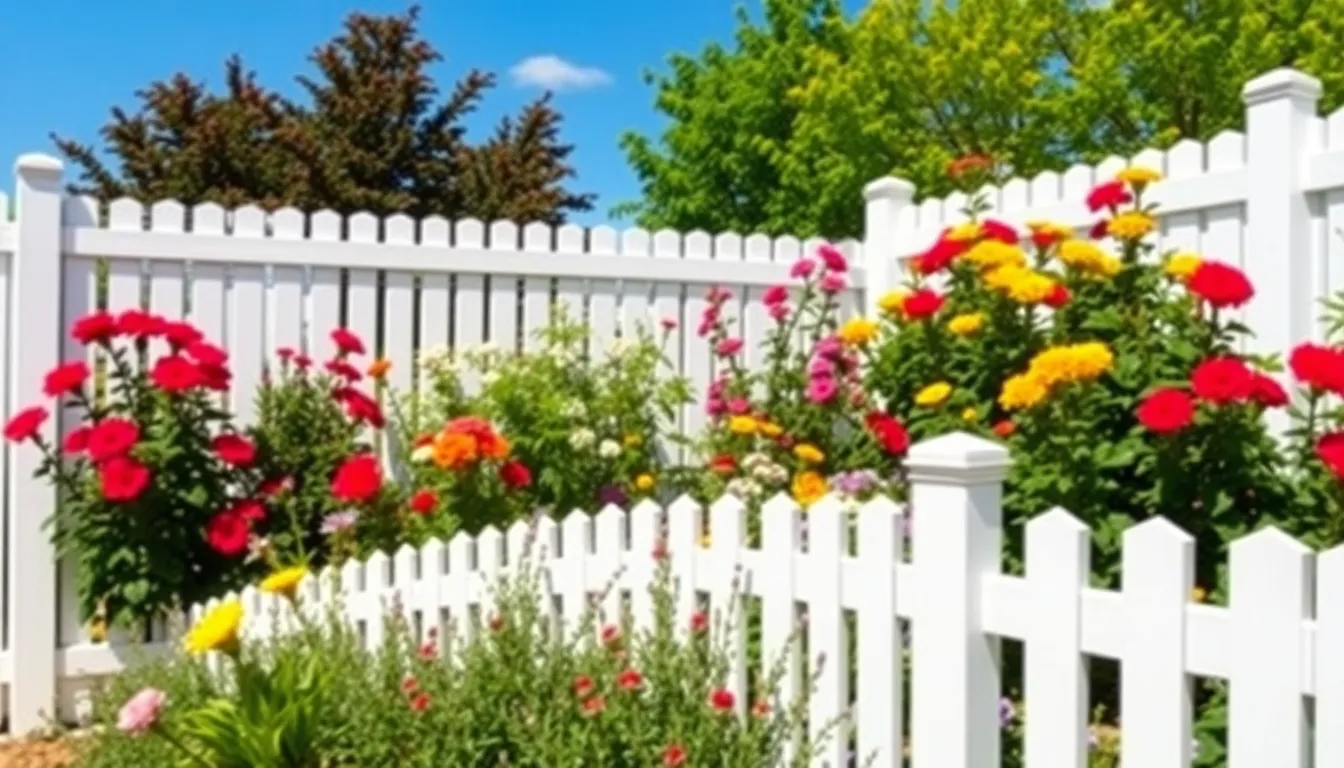
We understand that busy schedules make it challenging to maintain traditional fencing materials that require regular upkeep. Modern fence answers offer durability and style without the constant maintenance demands of wood options.
Vinyl Fence Installation Benefits
Vinyl fencing stands out as our top recommendation for gardeners who want lasting beauty without ongoing work. Durability makes vinyl fences resistant to damage from rot, decay, and insects that typically plague wood fencing materials. Easy installation requires less labor and fewer tools compared to traditional fence materials, making it perfect for weekend DIY projects.
Low maintenance eliminates the need for staining, sealing, or painting that wood fences demand every few years. Variety of colors provides multiple options to complement different garden styles and home exteriors. We’ve found that homeowners save hundreds of dollars annually by choosing vinyl over wood alternatives that require regular treatment and repairs.
| Vinyl Fence Benefits | Details |
|---|---|
| Rot Resistance | No decay or insect damage |
| Color Options | Multiple colors available |
| Installation Time | 50% faster than wood |
| Annual Maintenance Cost | $0 vs $200+ for wood |
Composite Fence Material Options
Composite fences combine wood and plastic materials to create our most balanced low maintenance solution. Durability ensures these fences withstand harsh weather conditions while maintaining their appearance for decades. Long lasting performance means composite materials won’t warp, crack, or fade like traditional wood fencing.
Minimal maintenance requirements include only occasional cleaning with soap and water. Cost effective answers provide excellent value when considering the total ownership costs over 20+ years. Aesthetic appeal matches the natural look of wood without the associated upkeep requirements.
Property value increases when homeowners install quality composite fencing that enhances curb appeal. We recommend composite options for gardens that need natural wood appearance without traditional wood maintenance demands.
Pre-Fabricated Fence Panel Systems
Pre-fabricated panels offer our fastest installation option for busy gardeners who need immediate results. Various materials include vinyl, composite, and aluminum options that suit different budget ranges and aesthetic preferences. Uniform look ensures consistent spacing and height throughout the entire fence line.
Time saving installation can reduce project completion from weeks to just a few days. Hassle free answers eliminate the guesswork involved in measuring, cutting, and spacing individual fence components. Easy installation makes these systems perfect for gardeners who want professional results without hiring contractors.
Aluminum slat panels provide modern horizontal designs with rust resistant properties that never require staining. Corrugated metal options deliver sleek industrial aesthetics while resisting weathering with minimal upkeep requirements.
Specialty Fence Ideas for Unique Garden Needs
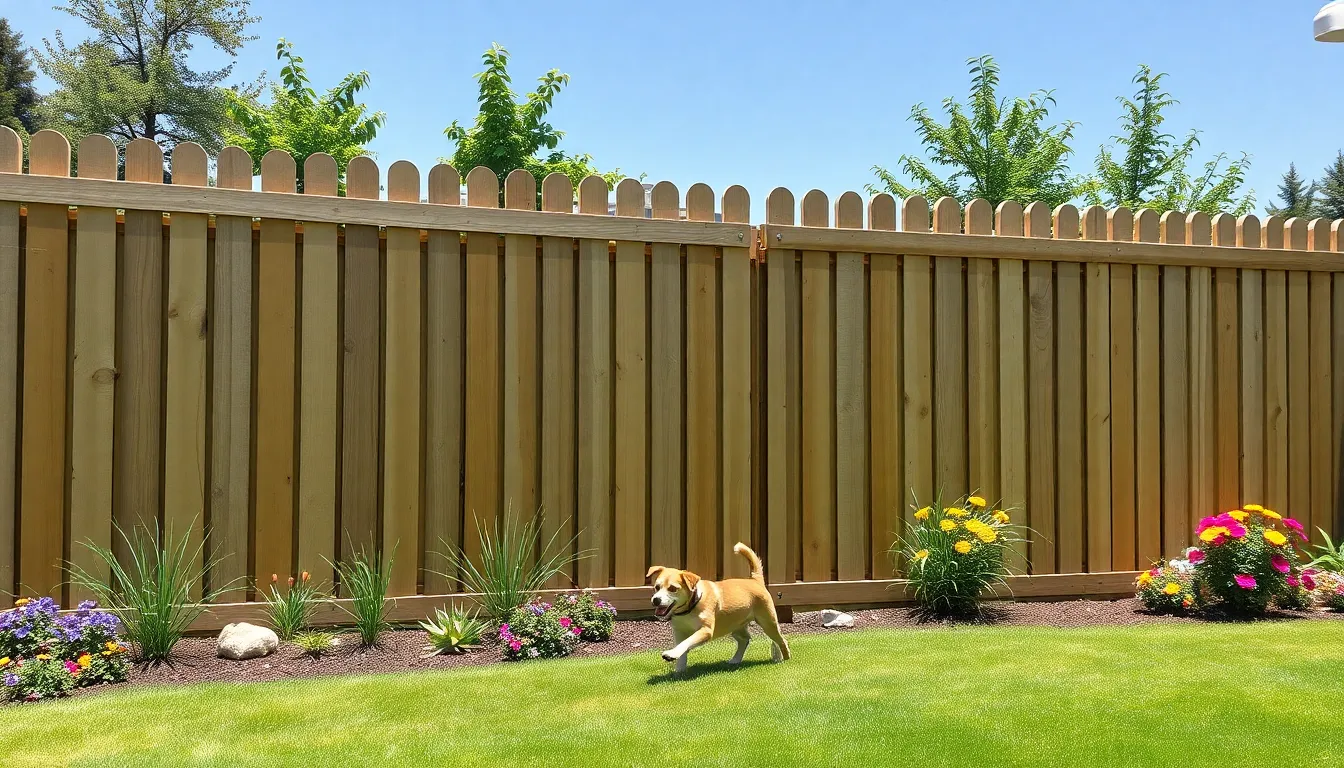
Every garden presents unique challenges that require specialized fencing answers to address exact needs. We’ve identified three critical areas where specialty fence design makes all the difference in creating safe and functional outdoor spaces.
Pet-Safe Fence Design Features
Height considerations form the foundation of effective pet containment, with fences needing adequate elevation to prevent pets from jumping over. We recommend combining this with durable materials like wood or metal that can withstand enthusiastic scratching and climbing attempts.
Gap prevention becomes crucial when designing for smaller pets, ensuring no openings exist that allow animals to slip through. Our experience shows that even minor spaces can become escape routes for determined pets.
Soft landscaping around fence perimeters provides an essential safety buffer, cushioning any impacts if pets attempt to jump or scratch against the barrier. This approach prevents injuries while maintaining the fence’s primary containment function.
Child-Friendly Fence Safety Options
Smooth edge construction eliminates sharp corners and rough surfaces that could cause injuries during play. We prioritize fence designs that feature rounded tops and sanded surfaces to create safe play environments.
Secure gate latches require adult operation while remaining difficult for children to manipulate. These specialized locking mechanisms provide controlled access while maintaining safety standards throughout the garden space.
Clear visibility through fence materials allows parents to supervise children effectively while maintaining boundaries. This transparency creates security without isolation, enabling natural oversight of outdoor activities.
Weather-Resistant Fence Materials
Pressure treated wood offers superior protection against rot and insect damage, extending fence lifespan significantly in challenging climates. This treatment process creates long lasting barriers that maintain structural integrity across seasons.
Vinyl fencing delivers exceptional durability with minimal maintenance requirements, resisting weathering effects that typically damage traditional materials. These installations require virtually no upkeep while maintaining their appearance year after year.
Metal construction provides maximum strength against harsh weather conditions, with various rust resistant finishes ensuring longevity. These robust materials withstand extreme temperatures, high winds, and moisture exposure without compromising their protective capabilities.
Conclusion
We’ve explored many fence ideas that can transform your garden into a beautiful and functional outdoor space. From classic wood designs to modern metal options each choice offers unique benefits that align with different needs and budgets.
Whether you’re seeking privacy through tall solid panels or embracing eco-friendly living fences your garden’s boundary should reflect your personal style. DIY enthusiasts can create stunning results with repurposed materials while those preferring low-maintenance answers will find vinyl and composite options ideal.
Remember that the perfect fence combines functionality with aesthetics. Consider factors like pet safety weather resistance and maintenance requirements when making your final decision.
Your garden fence is more than just a boundary—it’s an opportunity to enhance your property’s value and create the outdoor sanctuary you’ve always envisioned.
Frequently Asked Questions
What are the main benefits of choosing the right garden fence?
A well-selected garden fence enhances privacy, improves visual appeal, and protects plants from animals and weather. It also reflects your home’s personality, increases property value, and creates defined outdoor spaces. The right fence transforms your garden into an enjoyable sanctuary while providing practical functionality like security and boundary definition.
Which wood fence style is best for privacy?
Cedar privacy fences are the top choice for maximum privacy. They feature solid panels with minimal gaps, naturally resist decay and insects, and offer excellent durability. Cedar’s natural oils provide weather resistance, making it ideal for creating secluded garden spaces while maintaining an attractive, natural appearance.
Are metal fences suitable for modern gardens?
Yes, metal fences are perfect for contemporary gardens. Sleek aluminum panels offer minimalist aesthetics with low maintenance, while industrial steel provides strength and visual impact. Decorative wrought iron combines traditional charm with security. All metal options are durable, weather-resistant, and enhance modern garden sophistication.
What are living fences and how do they work?
Living fences use plants instead of traditional materials to create natural boundaries. Popular options include hedge varieties like boxwood and privet, bamboo installations, and vine-covered trellis systems. These eco-friendly solutions grow over time, provide wildlife habitat, improve air quality, and harmonize beautifully with garden landscapes.
Can I build an attractive fence on a tight budget?
Absolutely! DIY options include repurposed pallet fences, recycled material designs using old doors or windows, and simple wire-and-post solutions. These budget-friendly approaches can create unique, functional boundaries while keeping costs low. With creativity and basic tools, you can achieve beautiful fencing without breaking the bank.
How can I make my fence more decorative?
Enhance fence aesthetics with lattice patterns, ornamental tops like scalloped or arched designs, and colorful paint schemes. Consider stenciled patterns, chevron effects, or ombre transitions. Adding decorative elements transforms ordinary fencing into stunning garden features that complement your landscape design and personal style.
What fence height is best for privacy?
Tall solid panel fences, typically 6-8 feet high, provide maximum privacy by effectively blocking sight lines. However, check local regulations for height restrictions. Layered height variations and stepped designs can also enhance privacy while adding visual interest, creating secluded spaces without appearing fortress-like.
Which fence materials require the least maintenance?
Vinyl fencing requires the least maintenance, resisting rot, decay, and insects while needing only occasional cleaning. Composite materials combining wood and plastic offer similar low-maintenance benefits. These materials eliminate the need for regular staining, painting, or repairs, making them ideal for busy gardeners.
How do I choose a pet-safe fence?
Consider fence height based on your pet’s jumping ability, ensure gaps are too small for escape, and choose smooth materials to prevent injury. Secure gate latches and soft landscaping around the fence base enhance safety. The fence should effectively contain pets while allowing visibility for supervision.
What fence materials work best in harsh weather?
Pressure-treated wood, vinyl, and metal fences offer superior weather resistance. Vinyl withstands temperature extremes and moisture without warping or rotting. Aluminum resists corrosion, while properly treated wood handles various climates. Choose materials rated for your specific climate conditions to ensure longevity and performance.

